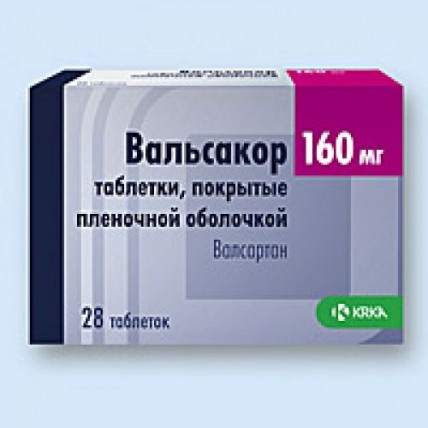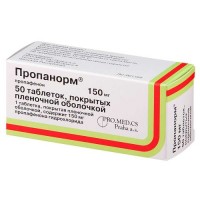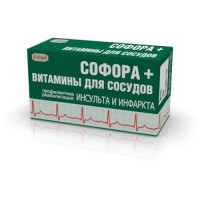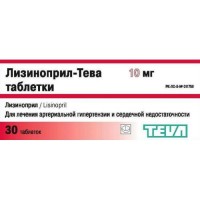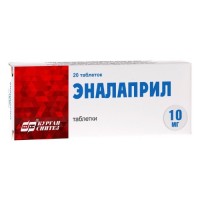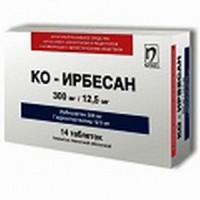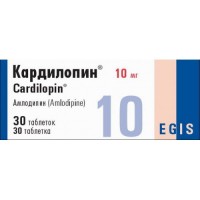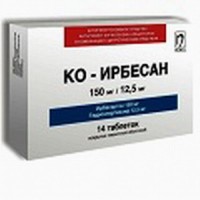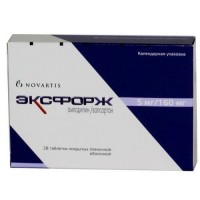Valsakor® 28's 160 mg film-coated tablets
- $29.70
The instruction for medical use
of VALSAKOR® medicine
the Trade name
of Valsakor®
the International unlicensed
name Valsartan Lekarstvennaya
the Tablet form, film coated 80 mg, 160 mg
Structure
One tablet contains
active agent: valsartana of 80 mg, 160 mg
excipients: lactoses monohydrate, cellulose microcrystalline, K 25 povidone, sodium of a kroskarmelloz, silicon dioxide colloidal anhydrous, magnesium stearate
structure of a film cover: a gipromelloza 6 sr, the titan E 171 dioxide, ferrous oxide red E 172, a macrogoal 4000, ferrous oxide yellow E 172 (for a dosage of 160 mg)
the Description
Round biconvex tablets, film coated pink color, with risky (for a dosage of 80 mg).
Oval biconvex tablets, film coated yellowish-brown color, with risky (for a dosage of 160 mg)
Pharmacotherapeutic group
the Drugs influencing a system renin-angiotensin. Angotenzina II antagonists. Valsartan
the ATX C09CA03 Code
the Pharmacological
Pharmacokinetics Absorption Later properties of reception of a valsartan inside the maximum concentration (Cmax) is reached within 2-4 hours. The average absolute bioavailability is 23%. When assigning with AUC food (the area on a curve concentration time) Cmax approximately for 50%, however, later after reception decreases 8 hours approximately by 40%, concentration of a valsartan in blood becomes identical at the patients taking the drug with food and at those who received drug separately. Decrease in AUC is not followed by clinically significant decrease in therapeutic effect of drug therefore valsartan it is possible to accept irrespective of meal.
Distribution
the Equilibrium volume of distribution of a valsartan makes about 17 l that demonstrates to what valsartan actively does not get into fabrics. Valsartan contacts serum proteins for 94-97%, generally albumine.
Biotransformation
Valsartan is not exposed to active biotransformation, only 20% break up to metabolites. In blood plasma the inactive hydroxymetabolite in low concentration (less than 10% of AUC of a valsartan) is found pharmacological.
Removal
the Half-life period of a valsartan makes about 6 hours. Valsartan is allocated mainly with bile and brought with a stake (about 83% of a dose) and through kidneys with urine (about 13% of a dose), generally in not changed look. Plasma clearance - about 2 l/h, renal clearance - 0.62 l/h (about 30% of the general clearance).
Patients with heart failure
the Average time of achievement of Cmax and elimination half-life of a valsartan at patients with heart failure same, as at healthy volunteers. Indicators of AUC and Cmax increase almost in proportion to increase in a dose (from 40 to 160 mg twice a day). Average coefficient of cumulation about 1.7. The seeming clearance after intake is about 4.5 l/h. The age of patients with heart failure does not affect the seeming clearance.
At elderly patients more significant system influence of a valsartan in comparison with young people is noted. However, this difference has no clinical importance.
At patients the connection between function of kidneys and system influence of a valsartan is not established with a renal failure therefore patients with impaired renal function do not require dose adjustment (if the clearance of creatine (CC) & gt, 10 ml/min.). Data on safety of a valsartan at patients with KK & lt, 10 ml/min. and also at patients, being on dialysis, no therefore such patients need to be careful when assigning a valsartan. Valsartan well contacts proteins of plasma and is not brought by dialysis.
At patients with a liver failure of easy and average degree the increase in AUC twice in comparison with patients with normal function of a liver is observed. However communication between concentration of a valsartan in blood plasma and weight of abnormal liver functions is not established.
Pharmacodynamics
of Valsakor® - antihypertensive drug which is a specific antagonist of receptors of angiotensin II (Ang II) intended for oral administration.
The AT1 subtype of receptors which are responsible for the known effects of angiotensin II affects selectively angiotenzivny. Increase after blockade of Valsakorom® of receptors of AT1 can stimulate not blocked AT2 receptor neutralizing action of a receptor of AT1 in angiotensin II level plasma. Вальсакор® does not render effect of the partial antagonist on receptors of AT1 and much quicker (approximately by 20,000 times) contacts AT1 receptors, than AT2 receptors. Вальсакор® also connects or blocks other receptors of hormones or ion channels which play an important role in work of a cardiovascular system. Вальсакор® does not suppress effect of the angiotensin-converting enzyme (ACE) (also known as a kininaza of II) which turns Ang I into Ang II and carries out bradykinin disintegration. Due to the lack of influence on APF and potentiation of bradykinin or substance P, anagonist of receptors of angiotensin II do not cause cough. It is authentically established that the number of cases of appearance of dry cough are much less among the patients receiving Valsakor® in comparison with the patients accepting APF (2.6% against 7.9%, respectively).
Arterial hypertension
Reception of Valsakora® at patients with hypertensia reduces arterial blood pressure without influence on the heart rate (HR).
At most of patients the antihypertensive effect develops during 2 h after reception of a single dose, reaches a maximum in 4 - 6 h and remains during 24 h. At regular reception the lasting antihypertensive effect is observed within 2 weeks. The maximum effect is reached within 4 weeks and remains at long-term treatment.
In a combination with a hydrochlorothiazide the additional considerable antihypertensive effect is reached. At the sharp termination of reception of Valsakora® there is no ricochet hypertensia or any other undesirable reactions.
At patients with hypertensia, type 2 diabetes and a microalbuminuria of Valsakor® reduces excretion of albumine with urine. It is proved that at patients with type 2 diabetes with a microalbuminuria, the normal or increased arterial blood pressure and without renal failure, reception of 160-320 mg of Valsakora® within 24 - 30 weeks reduces amount of albumine in urine approximately by 36 - 44%.
Recently postponed myocardial infarction
the efficiency of Valsakora® in decrease in over-all mortality at the patients with recently postponed myocardial infarction (with symptoms of appearance of a myocardial infarction during the period of 12 h up to 10 days) accepting treatment within 2 years Is proved.
Вальсакор® it is effective in increase in lifetime and decrease in death rate from cardiovascular diseases, hospitalization concerning heart failure, a repeated myocardial infarction, resuscitation owing to cardiac arrest and not fatal stroke (second compound final point).
The profile of safety of a valsartan will be coordinated with the clinical course of the disease at patients in a postinfarction state.
Вальсакор® can cause increase in level of creatinine in blood serum therefore at the patients who had a myocardial infarction obligatory assessment of function of kidneys is necessary.
Heart failure
At patients with heart failure of class II, III and IV on classification of the New York cardiological association (NYHA), with fraction of emission of a left ventricle & lt, 40% and the final diastolic diameter of a left ventricle (FDDLV) (& gt, 2.9 cm/m accepting valsartan are noted improvement of a functional class, considerable improvement of signs and symptoms of heart failure as short wind, fatigue, hypostases and rattles, improvement of quality of life, in comparison with initial in a final point, significant increase in fraction of emission and considerable decrease in KDDLZh, in comparison with initial in a final point.
Indications
Arterial hypertension
- treatment of essential hypertensia at adults, and arterial hypertension at children, teenagers aged from 6 up to 18 years
Recently postponed myocardial infarction
- treatment of clinically stable adult patients with symptoms of heart
failure or asymptomatic systolic dysfunction of a left
ventricle after recently postponed myocardial infarction
Heart failure
- treatment of symptomatic heart failure at adults at
impossibility of use of APF inhibitors or as addition
to therapy with APF inhibitors at impossibility of use
of beta-blockers)
accept the Route of administration and doses of the Tablet Valsakor® inside, washing down with water, irrespective of meal.
Arterial hypertension
Adults
the Recommended initial dose of Valsakora® makes 80 mg once a day. The antihypertensive effect is observed at reception within 2 weeks, and the maximum effect of administration of drug is reached within 4 weeks. Patients at whom arterial blood pressure is not controlled properly can increase a dose to 160 mg or to maximum - 320 mg.
Вальсакор® it is possible to accept with other drugs lowering arterial blood pressure. The concomitant use of diuretics (as a hydrochlorothiazide), promotes a bigger lowering of arterial pressure.
Children and teenagers aged from 6 up to 18 years
For children with body weight less than 35 kg the initial dose makes 40 mg once a day, for children with the body weight of 35 kg and more, the initial dose makes 80 mg once a day. The dose should be adjusted on the basis of results of arterial blood pressure. The maximum dose for children is provided below:
Body weight the Maximum dose
from ≥ 18 kg to & lt, 35 kg 80 mg
from ≥ 35 kg to & lt, 80 kg 160 mg
from ≥ 80 kg to ≤ 160 kg 320 mg
Use of higher doses is not recommended.
Children aged from 6 up to 18 years with a renal failure
At children with KK & lt, 30 ml/min. and at the children undergoing treatment by dialysis, use of Valsakora® is not recommended
At children with KK & gt, 30 ml/min. dose adjustment is not required.
It is necessary to control carefully function of kidneys and level of potassium in blood plasma.
Children aged from 6 up to 18 years with a liver failure
the Use of Valsakora® is contraindicated to children with a heavy liver failure, biliary cirrhosis and to patients with a cholestasia. Clinical experience of use of Valsakora® for children with a slight and moderate liver failure is limited. At such patients it is not necessary to exceed a dose of 80 mg.
At children and teenagers aged up to 18 years for treatment of heart failure or recently postponed myocardial infarction the use of Valsakora® is not recommended due to the lack of data on safety.
Adults
Recently postponed myocardial infarction
Clinically stable patients can begin treatment of Valsakorom® 12 hours later after a myocardial infarction. After use of an initial dose of 20 mg twice a day, it is possible to increase a dose to 40 mg, 80 mg and 160 mg twice a day within the next several weeks. The initial dose will be provided by reception of one tablet of 40 mg of Valsakora® halved.
The target maximum dose makes 160 mg twice a day. It is recommended that patients at first received doses on 80 mg twice a day within two weeks from the moment of an initiation of treatment and a target maximum dose of 160 mg twice a day within 3 months, depending on tolerance of drug the patient. In case of symptoms of hypotension or a renal failure, it is necessary to lower a drug dose.
Treatment of Valsakorom® can be carried out in parallel with other types of therapy after a myocardial infarction, for example trombolitika, acetylsalicylic acid, beta-blockers, statines and diuretics.
The concomitant use of drug with APF inhibitors is not recommended.
At inspection of the patients who had a myocardial infarction it is always necessary to carry out the assessment of function of kidneys.
Duration of therapy is established by the doctor.
Heart failure
the Recommended initial dose of Valsakora® makes 40 mg twice a day. Increase in a dose up to 80 mg and 160 mg twice a day, it is necessary to spend gradually with intervals not less than 2 weeks to the maximum dose, depending on tolerance of drug the patient. It is necessary to lower a dose of diuretics which are accepted together with Valsakorom®. The maximum daily dose makes 320 mg, divided into several receptions. Вальсакор® it is possible to accept along with other drugs for treatment of heart failure. However use of a ternary combination of APF inhibitor, a beta-blocker and Valsakora® is not recommended. At inspection of patients with heart failure the careful control of function of kidneys is necessary.
For treatment of elderly patients the correction of a dose is not required.
For patients with a renal failure (KK & gt, 10ml/mines or 0.167 ml / c) correction of a dose is not required.
For patients with easy and average degree of a liver failure without cholestasia the dose of Valsakora® should not exceed 80 mg.
Reception of Valsakora® is contraindicated to patients with a heavy liver failure, biliary cirrhosis and a cholestasia.
Side effects
At patients with arterial hypertension
not often (from & gt, 1/1.000 to & lt, 1/100):
- dizziness
- cough
- pain in a stomach
- fatigue
is not known (it cannot be estimated on the available data):
- decrease in level of hemoglobin, decrease in a hematocrit, a neutropenia,
thrombocytopenia
- allergic reactions, including a serum disease
- increase in level of potassium in blood serum, a hyponatremia
- a vasculitis
- increase in indicators of function of a liver, including increase in level
of bilirubin in blood serum
- a Quincke's edema, rash, an itching
- myalgia
- a renal failure or a renal failure, increase
in level of creatinine in blood serum
the Following side effects were observed during clinical trials without causal relationship with administration of drug: an arthralgia, an asthenia, a dorsodynia, diarrhea, dizziness, a headache, insomnia, decrease in a libido, nausea, peripheral swell, pharyngitis, rhinitis, sinusitis, upper respiratory tract infections, viral infections.
At the patients who had a myocardial infarction and/or with heart failure
Often (from & gt, 1/100 to & lt, 1/10):
- dizziness, postural dizziness
- hypotension, orthostatic hypotension
- a liver failure and abnormal liver functions
is not frequent (from & gt, 1/1.000 to & lt, 1/100):
- a hyperpotassemia
- a faint, headaches
- vertigo
- heart failure
- cough
- nausea, diarrhea
- a Quincke's disease
- an acute renal failure, increase in level of creatinine in
blood serum
- an asthenia, weakness
it is not known (it cannot be estimated on the available data):
- thrombocytopenia
- allergic reactions, including a serum disease
- increase in level of potassium in blood serum, a hyponatremia
- a vasculitis
- the increased values of indicators of a liver
- rash, an itching
-
Contraindication myalgia
- hypersensitivity to active agent or to any
of excipients
- a heavy liver failure, biliary cirrhosis,
a cholestasia
- pregnancy and the period of a lactation
- children's and teenage age up to 6 years
- a galactosemia, deficiency of Lappa lactase or a sprue
of glucose galactose
- simultaneous use of antagonists of receptors of angiotensin, including
Valsakor®, or APF inhibitors with aliskireny at patients with
diabetes 2 types
Medicinal interactions
Double blockade the system renin-angiotensin-aldosteronovoy (SRAA)
Simultaneous use of antagonists of receptors of angiotensin II, including a valsartan, or APF inhibitors with aliskireny at patients with diabetes or a renal failure (the glomerular filtration rate (GFR) & lt, 60 ml/min. / 1.73м2) is contraindicated.
It was reported about reversible increase in concentration of lithium in blood plasma and its toxicity during a concomitant use of APF inhibitors. In view of insufficient experience of simultaneous use of a valsartan and salt of lithium, the combination of these drugs is not recommended. In case concomitant use with valsartany, it is necessary to carry out careful monitoring of level of salt of lithium in blood serum.
Potassium additives, kaliysberegayushchy diuretics, the salt substitutes containing the potassium and other drugs increasing potassium level: in need of simultaneous use of a valsartan with the medicines influencing potassium level it is recommended to carry out monitoring of level of potassium in blood plasma.
Non-steroidal anti-inflammatory drugs (NPVP), including selection TsOG-2 inhibitors, acetylsalicylic acid & gt, 3 g a day and non-selective NPVP: at a concomitant use of antagonists of angiotensin II with NPVP there can be an easing of antihypertensive effect, the risk of deterioration in function of kidneys and increase in level of potassium in blood serum increases. Therefore, in an initiation of treatment it is recommended to carry out monitoring of function of kidneys. Plentiful drink is also recommended to such patients.
Conveyors: valsartan is substrate of hepatic capture OATP1B1/OATP1B3 and substrate of the conveyor of hepatic outflow of MRP2.
Simultaneous use of inhibitors of the conveyor of capture (for example, rifampicin, cyclosporine) or the outflow conveyor (for example, ritonavir) can increase system influence of a valsartan.
Other drugs: clinically significant interaction of a valsartan with Cimetidinum, warfarin, furosemide, digoxin, atenolol, indometacin, a hydrochlorothiazide, amlodipiny and glibenclamide is not revealed.
Special instructions
At patients with the reduced level of sodium and/or intercellular liquid which accept high doses of diuretics after an initiation of treatment valsartany, in rare instances can appear hypotension symptoms. Before an initiation of treatment valsartany it is necessary to make adjustment of level of sodium and/or intercellular liquid, for example, having lowered a diuretic dose.
In case of development of hypotension, the patient should be laid and, if necessary, to carry out intravenous infusion of isotonic solution of sodium of chloride. After arterial blood pressure is stabilized, treatment of Valsakorom® can be continued
For patients with a bilateral stenosis of renal arteries or a renal artery stenosis of the only kidney safety of use of a valsartan is not established. However, considering that the drugs influencing renin-angiotenzinovuyu a system can increase the level of urea nitrogen of blood and level of creatinine in blood serum at patients with a unilateral renal artery stenosis, during treatment valsartany it is recommended to carry out periodic monitoring of function of kidneys.
There is no sufficient experience of safe use of a valsartan for the patients who recently transferred renal transplantation now.
Patients with primary hyper aldosteronism should not accept valsartan as their renin-angiotenzinovaya the system is not activated.
Patients with a stenosis have mouths of an aorta and the mitral valve, a hypertrophic subaortic stenosis (GOKM), as well as in a case with other vasodilators, at treatment valsartany the extra care is required.
For patients with impaired renal function (КК>, 10 ml/min. or 0.167 ml / c) correction of a dose is not required. Data on safety of drug at patients with KK & lt, 10 ml/min. or 0.167 ml / with and at patients on dialysis are absent therefore this category of patients should be careful at treatment valsartany.
Simultaneous use of blockers of receptors of angiotensin, including
valsartan, and APF ingibitir together with aliskireny is contraindicated
to patients with a heavy renal failure (SKF & lt, 60 ml/min. / 1.73м2).
At patients without cholestasia at drug treatment it is necessary to be careful with easy or average degree of a liver failure.
Recently postponed myocardial infarction: the concomitant use of captopril and a valsartan did not show additional positive effect at treatment. The concomitant use of these two drugs increases risk of emergence of side effects unlike the proved therapy methods. In a type of it the concomitant use of Valsakora® and APF inhibitor is not recommended.
When assigning Valsakora® the patients who in recent time had a myocardial infarction should be careful. Assessment of a condition of patients with a myocardial infarction has to include the analysis of a condition of function of kidneys surely.
Reception of Valsakora® at patients with a myocardial infarction usually leads to a small lowering of arterial pressure, but at observance of a dosage according to the instruction usually there is no need of the termination of treatment.
At patients with heart failure, the combination of APF inhibitors, beta-blockers and a valsartana increases risk of undesirable reactions and therefore it is not recommended to use.
When assigning a valsartan the patients with heart failure should observe precautionary measures. Assessment of a condition of patients with heart failure has to include monitoring of function of kidneys surely. Reception of a valsartan at patients with heart failure usually leads to small lowering of arterial pressure, but at observance of a dosage according to the instruction usually there is no need of the termination of treatment.
At patients whose function of kidneys depends on activity system renin-angiotenzinovoy (for example, at patients with heavy stagnant heart failure) the treatment by APF inhibitors leads to an oliguria and/or the progressing azotemia, and in rare instances - to an acute renal failure and/or death. In view of the fact that valsartan is an antagonist of angiotensin II, it is impossible to exclude the probability that it can cause a renal failure.
Among the patients receiving valsartan it was reported about developing of a Quincke's disease (including a laryngeal edema and a glottis that leads to obstruction of airways and/or a face edema, lips, drinks and/or language), some of these patients tested a Quincke's edema at use of other drugs, including APF inhibitors earlier.
Use of Valsakora® should be cancelled immediately at patients at whom the Quincke's edema develops and not to apply repeatedly.
Double blockade the system renin-angiotensin-aldosteronovoy (SRAA)
At simultaneous use of the medicines influencing RAAS at sensitive patients the hypotonia, a faint, a stroke, a hyperpotassemia and changes of function of kidneys were registered (including an acute renal failure). The care at combined use of blockers of receptors of angiotensin, including a valsartan is required, with other blockers of RAAS, such as APF inhibitors or aliskiren.
Simultaneous use of antagonists of receptors of angiotensin II, including a valsartan, with APF or aliskireny at patients with diabetes or a renal failure (SKF & lt, 60 ml/min. / 1.73м2) is contraindicated.
Use for children with impaired renal function
Use of drug for children with КК<, 30 ml/min. and at the children undergoing treatment by dialysis was not investigated therefore Valsartan's use is not recommended to such patients. Dose adjustment at children with КК>, 30 ml/min. is not required. It is necessary to control carefully function of kidneys and level of potassium in blood plasma. It belongs, in particular, at use of a valsartan in the presence of other states (high temperature, dehydration) which can lead to deterioration in function of kidneys.
Use for children from the liver broken by function
Use of a valsartan is contraindicated at children with a heavy liver failure, biliary cirrhosis and at patients with a cholestasia. Clinical experience of use of a valsartan for children with a slight and moderate liver failure is limited. At such patients it is not necessary to exceed a dose of 80 mg of a valsartan.
Special instructions concerning
Valsakor® excipients contains lactose. Or the sprue of Valsakor® glucose galactose is contraindicated to patients with a galactosemia, deficiency of Lappa lactase.
Features of influence of medicine on ability to run the vehicle or potentially dangerous mechanisms of the Research of influence on ability to run motor transport and other mechanisms were not carried out. At control of motor transport or other mechanisms, it is necessary to consider the probability of developing of dizziness and exhaustion.
Overdose
Symptoms: lowering of arterial pressure, confusion of consciousness, acute vascular insufficiency and/or shock.
Treatment: depends on reception time and also symptoms and their weight.
First of all it is necessary to stabilize a hemodynamics.
In case of hypotension the patient has to be in a dorsal decubitus, at the same time it is necessary to carry out correction of volume of the circulating blood. The hemodialysis is not effective.
The form of release and packing
On 7, 10 or 14 tablets place in blister strip packaging from a film of PVC/PE/PVDC and aluminum foil.
On 2 or 4 (the blister on 7 tablets), 2, 3, 20 or 50 (the blister on 10 tablets), 1, 2, 10 or 40 (the blister on 14 tablets) planimetric packings together with the instruction for medical use in the state and Russian languages place in a pack from cardboard.
Storage conditions
In original packing at a temperature not higher than 30 ºС, in the place protected from moisture.
To store out of children's reach!
3 years
not to apply a period of storage after an expiration date.
Prescription status
According to the prescription
the Producer
of KRK, of. The place is new, Slovenia
Shmaryeshka 6, 8501 the place, Slovenia
the Owner of the registration certificate
of KRK, of Is new, the place Is new, Slovenia
the Address of the organization accepting in the territory of the Republic of Kazakhstan
claims from consumers on quality of products (goods)
of KRKA Kazakhstan LLP, RK, 050059, Almaty, Al-Farabi Ave. 19,
body 1b, the 2nd floor, the 207th office
ph. 8 (727) 311-08-09, fax 8 (727) 311-08-12
info.kz@krka.biz
to Develop
of VALSAKOR® medicine
the Trade name
of Valsakor®
the International unlicensed
name Valsartan Lekarstvennaya
the Tablet form, film coated 80 mg, 160 mg
Structure
One tablet contains
active agent: valsartana of 80 mg, 160 mg
excipients: lactoses monohydrate, cellulose microcrystalline, K 25 povidone, sodium of a kroskarmelloz, silicon dioxide colloidal anhydrous, magnesium stearate
structure of a film cover: a gipromelloza 6 sr, the titan E 171 dioxide, ferrous oxide red E 172, a macrogoal 4000, ferrous oxide yellow E 172 (for a dosage of 160 mg)
the Description
Round biconvex tablets, film coated pink color, with risky (for a dosage of 80 mg).
Oval biconvex tablets, film coated yellowish-brown color, with risky (for a dosage of 160 mg)
Pharmacotherapeutic group
the Drugs influencing a system renin-angiotensin. Angotenzina II antagonists. Valsartan
the ATX C09CA03 Code
the Pharmacological
Pharmacokinetics Absorption Later properties of reception of a valsartan inside the maximum concentration (Cmax) is reached within 2-4 hours. The average absolute bioavailability is 23%. When assigning with AUC food (the area on a curve concentration time) Cmax approximately for 50%, however, later after reception decreases 8 hours approximately by 40%, concentration of a valsartan in blood becomes identical at the patients taking the drug with food and at those who received drug separately. Decrease in AUC is not followed by clinically significant decrease in therapeutic effect of drug therefore valsartan it is possible to accept irrespective of meal.
Distribution
the Equilibrium volume of distribution of a valsartan makes about 17 l that demonstrates to what valsartan actively does not get into fabrics. Valsartan contacts serum proteins for 94-97%, generally albumine.
Biotransformation
Valsartan is not exposed to active biotransformation, only 20% break up to metabolites. In blood plasma the inactive hydroxymetabolite in low concentration (less than 10% of AUC of a valsartan) is found pharmacological.
Removal
the Half-life period of a valsartan makes about 6 hours. Valsartan is allocated mainly with bile and brought with a stake (about 83% of a dose) and through kidneys with urine (about 13% of a dose), generally in not changed look. Plasma clearance - about 2 l/h, renal clearance - 0.62 l/h (about 30% of the general clearance).
Patients with heart failure
the Average time of achievement of Cmax and elimination half-life of a valsartan at patients with heart failure same, as at healthy volunteers. Indicators of AUC and Cmax increase almost in proportion to increase in a dose (from 40 to 160 mg twice a day). Average coefficient of cumulation about 1.7. The seeming clearance after intake is about 4.5 l/h. The age of patients with heart failure does not affect the seeming clearance.
At elderly patients more significant system influence of a valsartan in comparison with young people is noted. However, this difference has no clinical importance.
At patients the connection between function of kidneys and system influence of a valsartan is not established with a renal failure therefore patients with impaired renal function do not require dose adjustment (if the clearance of creatine (CC) & gt, 10 ml/min.). Data on safety of a valsartan at patients with KK & lt, 10 ml/min. and also at patients, being on dialysis, no therefore such patients need to be careful when assigning a valsartan. Valsartan well contacts proteins of plasma and is not brought by dialysis.
At patients with a liver failure of easy and average degree the increase in AUC twice in comparison with patients with normal function of a liver is observed. However communication between concentration of a valsartan in blood plasma and weight of abnormal liver functions is not established.
Pharmacodynamics
of Valsakor® - antihypertensive drug which is a specific antagonist of receptors of angiotensin II (Ang II) intended for oral administration.
The AT1 subtype of receptors which are responsible for the known effects of angiotensin II affects selectively angiotenzivny. Increase after blockade of Valsakorom® of receptors of AT1 can stimulate not blocked AT2 receptor neutralizing action of a receptor of AT1 in angiotensin II level plasma. Вальсакор® does not render effect of the partial antagonist on receptors of AT1 and much quicker (approximately by 20,000 times) contacts AT1 receptors, than AT2 receptors. Вальсакор® also connects or blocks other receptors of hormones or ion channels which play an important role in work of a cardiovascular system. Вальсакор® does not suppress effect of the angiotensin-converting enzyme (ACE) (also known as a kininaza of II) which turns Ang I into Ang II and carries out bradykinin disintegration. Due to the lack of influence on APF and potentiation of bradykinin or substance P, anagonist of receptors of angiotensin II do not cause cough. It is authentically established that the number of cases of appearance of dry cough are much less among the patients receiving Valsakor® in comparison with the patients accepting APF (2.6% against 7.9%, respectively).
Arterial hypertension
Reception of Valsakora® at patients with hypertensia reduces arterial blood pressure without influence on the heart rate (HR).
At most of patients the antihypertensive effect develops during 2 h after reception of a single dose, reaches a maximum in 4 - 6 h and remains during 24 h. At regular reception the lasting antihypertensive effect is observed within 2 weeks. The maximum effect is reached within 4 weeks and remains at long-term treatment.
In a combination with a hydrochlorothiazide the additional considerable antihypertensive effect is reached. At the sharp termination of reception of Valsakora® there is no ricochet hypertensia or any other undesirable reactions.
At patients with hypertensia, type 2 diabetes and a microalbuminuria of Valsakor® reduces excretion of albumine with urine. It is proved that at patients with type 2 diabetes with a microalbuminuria, the normal or increased arterial blood pressure and without renal failure, reception of 160-320 mg of Valsakora® within 24 - 30 weeks reduces amount of albumine in urine approximately by 36 - 44%.
Recently postponed myocardial infarction
the efficiency of Valsakora® in decrease in over-all mortality at the patients with recently postponed myocardial infarction (with symptoms of appearance of a myocardial infarction during the period of 12 h up to 10 days) accepting treatment within 2 years Is proved.
Вальсакор® it is effective in increase in lifetime and decrease in death rate from cardiovascular diseases, hospitalization concerning heart failure, a repeated myocardial infarction, resuscitation owing to cardiac arrest and not fatal stroke (second compound final point).
The profile of safety of a valsartan will be coordinated with the clinical course of the disease at patients in a postinfarction state.
Вальсакор® can cause increase in level of creatinine in blood serum therefore at the patients who had a myocardial infarction obligatory assessment of function of kidneys is necessary.
Heart failure
At patients with heart failure of class II, III and IV on classification of the New York cardiological association (NYHA), with fraction of emission of a left ventricle & lt, 40% and the final diastolic diameter of a left ventricle (FDDLV) (& gt, 2.9 cm/m accepting valsartan are noted improvement of a functional class, considerable improvement of signs and symptoms of heart failure as short wind, fatigue, hypostases and rattles, improvement of quality of life, in comparison with initial in a final point, significant increase in fraction of emission and considerable decrease in KDDLZh, in comparison with initial in a final point.
Indications
Arterial hypertension
- treatment of essential hypertensia at adults, and arterial hypertension at children, teenagers aged from 6 up to 18 years
Recently postponed myocardial infarction
- treatment of clinically stable adult patients with symptoms of heart
failure or asymptomatic systolic dysfunction of a left
ventricle after recently postponed myocardial infarction
Heart failure
- treatment of symptomatic heart failure at adults at
impossibility of use of APF inhibitors or as addition
to therapy with APF inhibitors at impossibility of use
of beta-blockers)
accept the Route of administration and doses of the Tablet Valsakor® inside, washing down with water, irrespective of meal.
Arterial hypertension
Adults
the Recommended initial dose of Valsakora® makes 80 mg once a day. The antihypertensive effect is observed at reception within 2 weeks, and the maximum effect of administration of drug is reached within 4 weeks. Patients at whom arterial blood pressure is not controlled properly can increase a dose to 160 mg or to maximum - 320 mg.
Вальсакор® it is possible to accept with other drugs lowering arterial blood pressure. The concomitant use of diuretics (as a hydrochlorothiazide), promotes a bigger lowering of arterial pressure.
Children and teenagers aged from 6 up to 18 years
For children with body weight less than 35 kg the initial dose makes 40 mg once a day, for children with the body weight of 35 kg and more, the initial dose makes 80 mg once a day. The dose should be adjusted on the basis of results of arterial blood pressure. The maximum dose for children is provided below:
Body weight the Maximum dose
from ≥ 18 kg to & lt, 35 kg 80 mg
from ≥ 35 kg to & lt, 80 kg 160 mg
from ≥ 80 kg to ≤ 160 kg 320 mg
Use of higher doses is not recommended.
Children aged from 6 up to 18 years with a renal failure
At children with KK & lt, 30 ml/min. and at the children undergoing treatment by dialysis, use of Valsakora® is not recommended
At children with KK & gt, 30 ml/min. dose adjustment is not required.
It is necessary to control carefully function of kidneys and level of potassium in blood plasma.
Children aged from 6 up to 18 years with a liver failure
the Use of Valsakora® is contraindicated to children with a heavy liver failure, biliary cirrhosis and to patients with a cholestasia. Clinical experience of use of Valsakora® for children with a slight and moderate liver failure is limited. At such patients it is not necessary to exceed a dose of 80 mg.
At children and teenagers aged up to 18 years for treatment of heart failure or recently postponed myocardial infarction the use of Valsakora® is not recommended due to the lack of data on safety.
Adults
Recently postponed myocardial infarction
Clinically stable patients can begin treatment of Valsakorom® 12 hours later after a myocardial infarction. After use of an initial dose of 20 mg twice a day, it is possible to increase a dose to 40 mg, 80 mg and 160 mg twice a day within the next several weeks. The initial dose will be provided by reception of one tablet of 40 mg of Valsakora® halved.
The target maximum dose makes 160 mg twice a day. It is recommended that patients at first received doses on 80 mg twice a day within two weeks from the moment of an initiation of treatment and a target maximum dose of 160 mg twice a day within 3 months, depending on tolerance of drug the patient. In case of symptoms of hypotension or a renal failure, it is necessary to lower a drug dose.
Treatment of Valsakorom® can be carried out in parallel with other types of therapy after a myocardial infarction, for example trombolitika, acetylsalicylic acid, beta-blockers, statines and diuretics.
The concomitant use of drug with APF inhibitors is not recommended.
At inspection of the patients who had a myocardial infarction it is always necessary to carry out the assessment of function of kidneys.
Duration of therapy is established by the doctor.
Heart failure
the Recommended initial dose of Valsakora® makes 40 mg twice a day. Increase in a dose up to 80 mg and 160 mg twice a day, it is necessary to spend gradually with intervals not less than 2 weeks to the maximum dose, depending on tolerance of drug the patient. It is necessary to lower a dose of diuretics which are accepted together with Valsakorom®. The maximum daily dose makes 320 mg, divided into several receptions. Вальсакор® it is possible to accept along with other drugs for treatment of heart failure. However use of a ternary combination of APF inhibitor, a beta-blocker and Valsakora® is not recommended. At inspection of patients with heart failure the careful control of function of kidneys is necessary.
For treatment of elderly patients the correction of a dose is not required.
For patients with a renal failure (KK & gt, 10ml/mines or 0.167 ml / c) correction of a dose is not required.
For patients with easy and average degree of a liver failure without cholestasia the dose of Valsakora® should not exceed 80 mg.
Reception of Valsakora® is contraindicated to patients with a heavy liver failure, biliary cirrhosis and a cholestasia.
Side effects
At patients with arterial hypertension
not often (from & gt, 1/1.000 to & lt, 1/100):
- dizziness
- cough
- pain in a stomach
- fatigue
is not known (it cannot be estimated on the available data):
- decrease in level of hemoglobin, decrease in a hematocrit, a neutropenia,
thrombocytopenia
- allergic reactions, including a serum disease
- increase in level of potassium in blood serum, a hyponatremia
- a vasculitis
- increase in indicators of function of a liver, including increase in level
of bilirubin in blood serum
- a Quincke's edema, rash, an itching
- myalgia
- a renal failure or a renal failure, increase
in level of creatinine in blood serum
the Following side effects were observed during clinical trials without causal relationship with administration of drug: an arthralgia, an asthenia, a dorsodynia, diarrhea, dizziness, a headache, insomnia, decrease in a libido, nausea, peripheral swell, pharyngitis, rhinitis, sinusitis, upper respiratory tract infections, viral infections.
At the patients who had a myocardial infarction and/or with heart failure
Often (from & gt, 1/100 to & lt, 1/10):
- dizziness, postural dizziness
- hypotension, orthostatic hypotension
- a liver failure and abnormal liver functions
is not frequent (from & gt, 1/1.000 to & lt, 1/100):
- a hyperpotassemia
- a faint, headaches
- vertigo
- heart failure
- cough
- nausea, diarrhea
- a Quincke's disease
- an acute renal failure, increase in level of creatinine in
blood serum
- an asthenia, weakness
it is not known (it cannot be estimated on the available data):
- thrombocytopenia
- allergic reactions, including a serum disease
- increase in level of potassium in blood serum, a hyponatremia
- a vasculitis
- the increased values of indicators of a liver
- rash, an itching
-
Contraindication myalgia
- hypersensitivity to active agent or to any
of excipients
- a heavy liver failure, biliary cirrhosis,
a cholestasia
- pregnancy and the period of a lactation
- children's and teenage age up to 6 years
- a galactosemia, deficiency of Lappa lactase or a sprue
of glucose galactose
- simultaneous use of antagonists of receptors of angiotensin, including
Valsakor®, or APF inhibitors with aliskireny at patients with
diabetes 2 types
Medicinal interactions
Double blockade the system renin-angiotensin-aldosteronovoy (SRAA)
Simultaneous use of antagonists of receptors of angiotensin II, including a valsartan, or APF inhibitors with aliskireny at patients with diabetes or a renal failure (the glomerular filtration rate (GFR) & lt, 60 ml/min. / 1.73м2) is contraindicated.
It was reported about reversible increase in concentration of lithium in blood plasma and its toxicity during a concomitant use of APF inhibitors. In view of insufficient experience of simultaneous use of a valsartan and salt of lithium, the combination of these drugs is not recommended. In case concomitant use with valsartany, it is necessary to carry out careful monitoring of level of salt of lithium in blood serum.
Potassium additives, kaliysberegayushchy diuretics, the salt substitutes containing the potassium and other drugs increasing potassium level: in need of simultaneous use of a valsartan with the medicines influencing potassium level it is recommended to carry out monitoring of level of potassium in blood plasma.
Non-steroidal anti-inflammatory drugs (NPVP), including selection TsOG-2 inhibitors, acetylsalicylic acid & gt, 3 g a day and non-selective NPVP: at a concomitant use of antagonists of angiotensin II with NPVP there can be an easing of antihypertensive effect, the risk of deterioration in function of kidneys and increase in level of potassium in blood serum increases. Therefore, in an initiation of treatment it is recommended to carry out monitoring of function of kidneys. Plentiful drink is also recommended to such patients.
Conveyors: valsartan is substrate of hepatic capture OATP1B1/OATP1B3 and substrate of the conveyor of hepatic outflow of MRP2.
Simultaneous use of inhibitors of the conveyor of capture (for example, rifampicin, cyclosporine) or the outflow conveyor (for example, ritonavir) can increase system influence of a valsartan.
Other drugs: clinically significant interaction of a valsartan with Cimetidinum, warfarin, furosemide, digoxin, atenolol, indometacin, a hydrochlorothiazide, amlodipiny and glibenclamide is not revealed.
Special instructions
At patients with the reduced level of sodium and/or intercellular liquid which accept high doses of diuretics after an initiation of treatment valsartany, in rare instances can appear hypotension symptoms. Before an initiation of treatment valsartany it is necessary to make adjustment of level of sodium and/or intercellular liquid, for example, having lowered a diuretic dose.
In case of development of hypotension, the patient should be laid and, if necessary, to carry out intravenous infusion of isotonic solution of sodium of chloride. After arterial blood pressure is stabilized, treatment of Valsakorom® can be continued
For patients with a bilateral stenosis of renal arteries or a renal artery stenosis of the only kidney safety of use of a valsartan is not established. However, considering that the drugs influencing renin-angiotenzinovuyu a system can increase the level of urea nitrogen of blood and level of creatinine in blood serum at patients with a unilateral renal artery stenosis, during treatment valsartany it is recommended to carry out periodic monitoring of function of kidneys.
There is no sufficient experience of safe use of a valsartan for the patients who recently transferred renal transplantation now.
Patients with primary hyper aldosteronism should not accept valsartan as their renin-angiotenzinovaya the system is not activated.
Patients with a stenosis have mouths of an aorta and the mitral valve, a hypertrophic subaortic stenosis (GOKM), as well as in a case with other vasodilators, at treatment valsartany the extra care is required.
For patients with impaired renal function (КК>, 10 ml/min. or 0.167 ml / c) correction of a dose is not required. Data on safety of drug at patients with KK & lt, 10 ml/min. or 0.167 ml / with and at patients on dialysis are absent therefore this category of patients should be careful at treatment valsartany.
Simultaneous use of blockers of receptors of angiotensin, including
valsartan, and APF ingibitir together with aliskireny is contraindicated
to patients with a heavy renal failure (SKF & lt, 60 ml/min. / 1.73м2).
At patients without cholestasia at drug treatment it is necessary to be careful with easy or average degree of a liver failure.
Recently postponed myocardial infarction: the concomitant use of captopril and a valsartan did not show additional positive effect at treatment. The concomitant use of these two drugs increases risk of emergence of side effects unlike the proved therapy methods. In a type of it the concomitant use of Valsakora® and APF inhibitor is not recommended.
When assigning Valsakora® the patients who in recent time had a myocardial infarction should be careful. Assessment of a condition of patients with a myocardial infarction has to include the analysis of a condition of function of kidneys surely.
Reception of Valsakora® at patients with a myocardial infarction usually leads to a small lowering of arterial pressure, but at observance of a dosage according to the instruction usually there is no need of the termination of treatment.
At patients with heart failure, the combination of APF inhibitors, beta-blockers and a valsartana increases risk of undesirable reactions and therefore it is not recommended to use.
When assigning a valsartan the patients with heart failure should observe precautionary measures. Assessment of a condition of patients with heart failure has to include monitoring of function of kidneys surely. Reception of a valsartan at patients with heart failure usually leads to small lowering of arterial pressure, but at observance of a dosage according to the instruction usually there is no need of the termination of treatment.
At patients whose function of kidneys depends on activity system renin-angiotenzinovoy (for example, at patients with heavy stagnant heart failure) the treatment by APF inhibitors leads to an oliguria and/or the progressing azotemia, and in rare instances - to an acute renal failure and/or death. In view of the fact that valsartan is an antagonist of angiotensin II, it is impossible to exclude the probability that it can cause a renal failure.
Among the patients receiving valsartan it was reported about developing of a Quincke's disease (including a laryngeal edema and a glottis that leads to obstruction of airways and/or a face edema, lips, drinks and/or language), some of these patients tested a Quincke's edema at use of other drugs, including APF inhibitors earlier.
Use of Valsakora® should be cancelled immediately at patients at whom the Quincke's edema develops and not to apply repeatedly.
Double blockade the system renin-angiotensin-aldosteronovoy (SRAA)
At simultaneous use of the medicines influencing RAAS at sensitive patients the hypotonia, a faint, a stroke, a hyperpotassemia and changes of function of kidneys were registered (including an acute renal failure). The care at combined use of blockers of receptors of angiotensin, including a valsartan is required, with other blockers of RAAS, such as APF inhibitors or aliskiren.
Simultaneous use of antagonists of receptors of angiotensin II, including a valsartan, with APF or aliskireny at patients with diabetes or a renal failure (SKF & lt, 60 ml/min. / 1.73м2) is contraindicated.
Use for children with impaired renal function
Use of drug for children with КК<, 30 ml/min. and at the children undergoing treatment by dialysis was not investigated therefore Valsartan's use is not recommended to such patients. Dose adjustment at children with КК>, 30 ml/min. is not required. It is necessary to control carefully function of kidneys and level of potassium in blood plasma. It belongs, in particular, at use of a valsartan in the presence of other states (high temperature, dehydration) which can lead to deterioration in function of kidneys.
Use for children from the liver broken by function
Use of a valsartan is contraindicated at children with a heavy liver failure, biliary cirrhosis and at patients with a cholestasia. Clinical experience of use of a valsartan for children with a slight and moderate liver failure is limited. At such patients it is not necessary to exceed a dose of 80 mg of a valsartan.
Special instructions concerning
Valsakor® excipients contains lactose. Or the sprue of Valsakor® glucose galactose is contraindicated to patients with a galactosemia, deficiency of Lappa lactase.
Features of influence of medicine on ability to run the vehicle or potentially dangerous mechanisms of the Research of influence on ability to run motor transport and other mechanisms were not carried out. At control of motor transport or other mechanisms, it is necessary to consider the probability of developing of dizziness and exhaustion.
Overdose
Symptoms: lowering of arterial pressure, confusion of consciousness, acute vascular insufficiency and/or shock.
Treatment: depends on reception time and also symptoms and their weight.
First of all it is necessary to stabilize a hemodynamics.
In case of hypotension the patient has to be in a dorsal decubitus, at the same time it is necessary to carry out correction of volume of the circulating blood. The hemodialysis is not effective.
The form of release and packing
On 7, 10 or 14 tablets place in blister strip packaging from a film of PVC/PE/PVDC and aluminum foil.
On 2 or 4 (the blister on 7 tablets), 2, 3, 20 or 50 (the blister on 10 tablets), 1, 2, 10 or 40 (the blister on 14 tablets) planimetric packings together with the instruction for medical use in the state and Russian languages place in a pack from cardboard.
Storage conditions
In original packing at a temperature not higher than 30 ºС, in the place protected from moisture.
To store out of children's reach!
3 years
not to apply a period of storage after an expiration date.
Prescription status
According to the prescription
the Producer
of KRK, of. The place is new, Slovenia
Shmaryeshka 6, 8501 the place, Slovenia
the Owner of the registration certificate
of KRK, of Is new, the place Is new, Slovenia
the Address of the organization accepting in the territory of the Republic of Kazakhstan
claims from consumers on quality of products (goods)
of KRKA Kazakhstan LLP, RK, 050059, Almaty, Al-Farabi Ave. 19,
body 1b, the 2nd floor, the 207th office
ph. 8 (727) 311-08-09, fax 8 (727) 311-08-12
info.kz@krka.biz
to Develop
